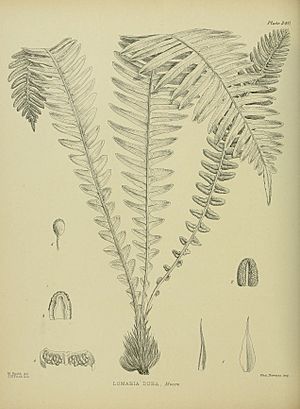Austroblechnum durum facts for kids
Quick facts for kids Austroblechnum durum |
|
|---|---|
 |
|
| Scientific classification | |
| Synonyms | |
|
Austroblechnum durum, also known as Blechnum durum, is a type of fern. It belongs to the Blechnaceae family. This fern is special because it only grows naturally in New Zealand. This means it is an endemic species.
Contents
What Does It Look Like?
This fern has long leaves, called fronds. They can be about 30 centimeters (1 foot) or more in length. The fronds are firm and somewhat thick. They have many small parts called pinnae or segments.
Frond Details
The pinnae are close together. They are rounded at the ends and have smooth edges. The ones in the middle are oblong, meaning they are longer than they are wide. The top pinnae get smaller towards the tip. The lower ones are small and rounded.
How It Grows
The fern's stem, called a caudex, stands upright. It can even look a bit like a small tree trunk. The leaf stalks are short, about 2.5 centimeters (1 inch) long. They have small, oval-shaped scales at their base.
How Was It Named?
The fern was first described by a botanist named Thomas Moore. He wrote about it in 1866 in a publication called The Gardeners' Chronicle. He first named it Lomaria dura.
Where the Name Came From
Moore's description was based on a fern that was grown in a garden. This plant had been collected by Henry H. Travers. He found it on the Chatham Islands in 1871.
Where Does It Live?
Austroblechnum durum has a specific home. It grows in coastal forests in the South Island of New Zealand. You can find it from south of Okuru and the Haast River all the way east to the Catlins area.
Other Locations
This fern also grows on Stewart Island. It likes to live on the forest floor. It often grows alongside other ferns like Austroblechnum leyboldtianum, A. lanceolatum, and A. colensoi. These forests are a mix of hardwood trees and podocarp trees.

